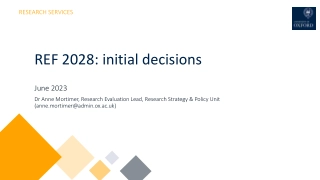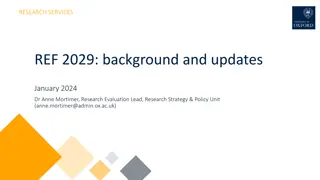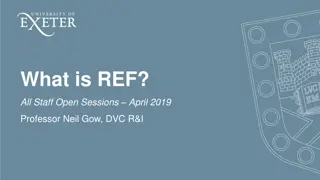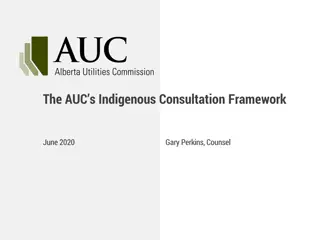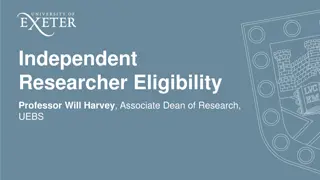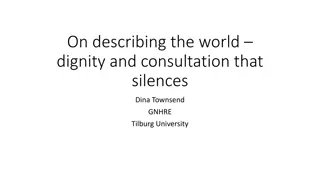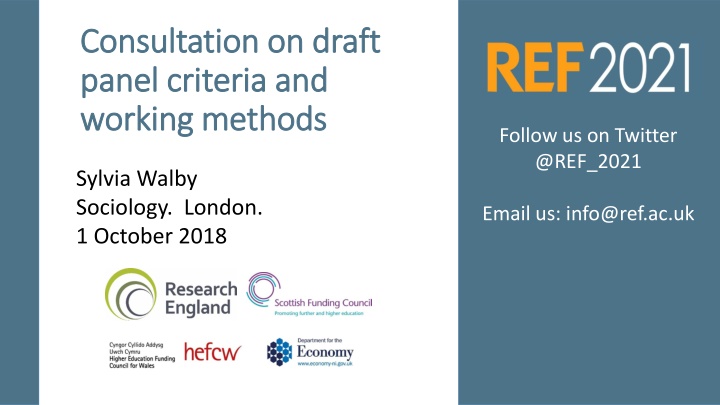
Consultation on Draft Panel Criteria and Working Methods for REF 2021
Learn about the key changes in the REF 2021 framework, including the submission criteria and working methods for expert panels. Explore the specific consultation areas and guidance on submissions in this comprehensive consultation document.
Download Presentation

Please find below an Image/Link to download the presentation.
The content on the website is provided AS IS for your information and personal use only. It may not be sold, licensed, or shared on other websites without obtaining consent from the author. If you encounter any issues during the download, it is possible that the publisher has removed the file from their server.
You are allowed to download the files provided on this website for personal or commercial use, subject to the condition that they are used lawfully. All files are the property of their respective owners.
The content on the website is provided AS IS for your information and personal use only. It may not be sold, licensed, or shared on other websites without obtaining consent from the author.
E N D
Presentation Transcript
Consultation on draft Consultation on draft panel criteria and panel criteria and working methods working methods Follow us on Twitter @REF_2021 Sylvia Walby Sociology. London. 1 October 2018 Email us: info@ref.ac.uk
2021 framework Overall quality Impact Environment Outputs FTE x 2.5 = number of outputs required Environment data and template Impact case studies 60% 15% 25%
Key changes since REF 2014 Overall framework Overall framework Submission of all staff with significant responsibility for research Transitional approach to non-portability of outputs Decoupling of staff from outputs Open access requirements Additional measures to support interdisciplinary research Broadening and deepening definitions of impact
Guidance on submissions Specific consultation areas Specific consultation areas clarity, usefulness and coverage of the list of independent research fellowships proposed eligibility arrangements for seconded staff proposed ineligibility of staff based in a discrete department or unit outside the UK proposed approach for taking account of staff circumstances clarity and usefulness of the glossary of output types proposal to make ineligible the outputs of former staff who have been made redundant (except where the staff member has taken voluntary redundancy) proposed intention to permit the submission of co-authored outputs only once within the same submission PLUS comments on overall clarity of the guidance, including annexes
Expert panels 34 sub-panels working under the guidance of four main panels with advice from Equality and Diversity and Interdisciplinary Research advisory panels (EDAP and IDAP) Two-stage appointment process (via nominations): 1. Criteria-setting phase sufficient members appointed to ensure each sub-panel has appropriate expertise 2. Assessment phase recruitment in 2020 of additional panel members and assessors to ensure appropriate breadth of expertise and number of panel members necessary for the assessment phase, informed by the survey of institutions submission intentions in 2019.
Main panel UOAs Unit of assessment 14 Geography and Environmental Studies Archaeology 15 Economics and Econometrics 16 Business and Management Studies 17 Main panel Law 18 Unit of assessment Politics and International Studies C 19 Clinical Medicine 1 Social Work and Social Policy 20 Public Health, Health Services and Primary Care 2 Sociology 21 Allied Health Professions, Dentistry, Nursing and Pharmacy 3 Anthropology and Development Studies 22 A Psychology, Psychiatry and Neuroscience 4 Education 23 Biological Sciences 5 Sport and Exercise Sciences, Leisure and Tourism 24 Agriculture, Food and Veterinary Sciences 6 Area Studies 25 Earth Systems and Environmental Sciences 7 Modern Languages and Linguistics 26 Chemistry 8 English Language and Literature 27 Physics 9 History 28 B 10 Mathematical Sciences Classics 29 11 Computer Science and Informatics D Philosophy 30 12 Engineering Theology and Religious Studies 31 Art and Design: History, Practice and Theory 32 Music, Drama, Dance, Performing Arts, Film and Screen Studies 33 Communication, Cultural and Media Studies, Library and Information Management 34
Interdisciplinary advisers Interdisciplinary Research Advisory Panel oversee application of agreed principles and processes Main panel interdisciplinary leads facilitate cross-panel liaison oversee calibration exercise for IDR outputs Sub-panel Offer guidance to sub-panels on assessment of IDR outputs Liaise with advisers on other panels interdisciplinary advisers
Expert panels Main panel responsibilities Main panel responsibilities Sub Sub- -panel responsibilities panel responsibilities Developing the panel criteria and working methods Contributing to the main panel criteria and working methods Ensuring adherence to the criteria/procedures and consistent application of the overall assessment standards Assessing submissions and recommending the outcomes Signing off the outcomes
Panel criteria Aims Aims build on REF 2014 criteria to maintain continuity achieve consistency across the main panels, where possible, while taking into account disciplinary differences Structure Structure Unit of assessment (UOA) descriptors Panel criteria (submissions, outputs, impact, environment) Panel procedures Working methods
Panel criteria - consultation We invite comments on: We invite comments on: whether the criteria are appropriate and clear where further clarification is required where refinements could be made where more consistency across panels could be achieved where differences between disciplines could justify further differentiation between main panels PLUS specific questions on: PLUS specific questions on: double-weighted outputs Main Panel D guidance on output types section weightings in the Environment statement
Outputs Assessed against three criteria: Assessed against three criteria: Rigour Significance Originality the extent to which the output makes an important and innovative contribution to understanding and knowledge in the field the extent to which the work has influenced, or has the capacity to influence, knowledge and scholarly thought, or the development and understanding of policy and/or practice the extent to which the work demonstrates intellectual coherence and integrity, and adopts robust and appropriate concepts, analyses, theories and methodologies Scored one to four star (or unclassified) Scored one to four star (or unclassified) Each main panel sets out its own understanding of the starred quality levels
Outputs interdisciplinary research For the purposes of the REF, interdisciplinary research is understood to achieve outcomes (including new approaches) that could not be achieved within the framework of a single discipline. Interdisciplinary research features significant interaction between two or more disciplines and / or moves beyond established disciplinary foundations in applying or integrating research approaches from other disciplines. HEIs are invited to identify outputs that meet this definition. This process is distinct from from a request for cross-referral. There will be no advantage or disadvantage no advantage or disadvantage in the assessment in identifying outputs as interdisciplinary. is distinct
Outputs co-authored Institutions may only attribute co-authored outputs to individual members of staff who made a substantial research contribution a substantial research contribution to the output Main Panel A: For each submitted co-authored output where there are ten or more authors and where the submitted member of staff is not identified as the lead or corresponding author, institutions are required to affirm the substantial contribution to the research by the submitted member of staff. Main Panel B: for outputs with more than 25 co more than 25 co- -authors required about the author s contribution Main Panels C and D: not require the submission of information about the individual co-author s contribution but may seek to verify via audit. ten or more authors, specific information is
Outputs double-weighting Double-weighting may be requested where the scale of academic investment in the research activity and/or the intellectual scope of the research output is considerably greater than the disciplinary norm. Submit a 100-word statement HEIs may submit a reserve output, should the request not be accepted. This does not have to be attributed to the same member of staff but must be in accordance with min. 1 and max. 5 outputs attributed to staff. Main panels set out their individual expectations does not Specific consultation on: proposed criteria for double-weighting outputs in Main Panels C and D whether requests to double-weight books should automatically be accepted?
Outputs additional information For Main Panel D, an output will either consist of a single item (e.g. a journal article, a book), or an integrated presentation of a range of material that makes clear research dimensions research dimensions of the submitted work. The material submitted and 300-word statement (where required) should provide evidence of: the research process the research insights the dissemination Should be presented as a coherent package to assist panel members to access fully the research dimensions of the work makes clear the
Outputs citation data All sub-panels will use citation data (where available), as potential indicator of academic significance Main Panel A Sub-panels 7, 8, 9 and 11 will receive citation data (where available), as part of indicator of academic significance Main Panel B Sub-panel 16 will receive citation data (where available), and will use where it is considered appropriate as an additional piece of supplementary evidence Main Panel C Main Panel D No sub-panels will receive or use citation data
Impact submission Submission: Submission: Impact remains eligible for submission by institution(s) where research was generated (i.e. non-portable) Impact must be underpinned by research of minimum 2* quality Timeframe: 1 January 2000 - 31 December 2020 for underpinning research 1 August 2013 - 31 July 2020 for impacts Case studies continued from examples submitted in 2014 will be eligible for submission in REF 2021, provided they meet the same eligibility criteria provided they meet the same eligibility criteria
Impact criteria Assessed against two criteria: Reach Significance the extent and/or diversity of the beneficiaries of the impact, as relevant to the nature of the impact. (It will not be assessed in geographic terms, nor in terms of absolute numbers of beneficiaries.) the degree to which the impact has enabled, enriched, influenced, informed or changed the performance, policies, practices, products, services, understanding, awareness or well-being of the beneficiaries.
Impact types and indicators Panels welcome case studies that describe any type(s) Panel will welcome, and assess equitably, case studies describing impacts achieved through public engagement, either as the main impact described or as one facet of a wider range of impacts. Impact on teaching within (and beyond) own HEI is eligible Case studies must provide a clear and coherent narrative supported by verifiable evidence and indicators Should provide evidence of reach and significance of the impacts evidence of dissemination or uptake Annex A includes an extensive but not exhaustive list of examples of impact and indicators, including evaluation frameworks from non-HE organisations any type(s) of impact impacts, as distinct from
Impact underpinning research Panels recognise that the relationship between research and impact can be indirect and non-linear Underpinning research as a whole must be min. 2* quality Case studies must include up to six key references (not every output referenced has to be 2*) HEIs can consult the outputs glossary in the Guidance on submissions Can also include indicators of quality e.g. evidence of peer-reviewed funding, prizes or awards for individual outputs etc. May be a body of work produced over a number of years or may be the output(s) of a particular project
Environment Assessment criteria: Vitality Sustainability the extent to which a unit supports a thriving and inclusive research culture for all staff and research students, that is based on a clearly articulated strategy for research and enabling its impact, is engaged with the national and international research and user communities and is able to attract excellent postgraduate and postdoctoral researchers. the extent to which the research environment ensures the future health, diversity, well-being and wider contribution of the unit and the discipline(s), including investment in people and in infrastructure.
Environment template Sections Sections a. Unit context, research and impact strategy. b. People, including: a. staffing strategy and staff development b. research students c. equality and diversity. c. Income, infrastructure and facilities. d. Collaboration and contribution to the research base, economy and society. Information about the unit s support for impact to be included across the four sections
Environment template Weighting Weighting Main Panel A, B and C will attach equal weighting to each of the four sections Recognising the primary role that people play as the key resource in the arts and humanities, Main Panel D will attach differential weight to sections: Unit context and structure, research and impact strategy (25%) People (30%) Income, infrastructure and facilities (20%) Collaboration and contribution to the research base, economy and society (25%) Specific consultation on whether the difference in section weightings across main panels is sufficiently justified by disciplinary difference
Institutional level assessment of environment Institutional-level information will be appended to the UOA-level environment template and will be taken into account by the sub-panel when assessing the unit-level statement. Pilot of the standalone assessment of the discrete institutional-level environment will draw on this submitted information. Outcomes from the separate pilot exercise will not 2021 but will inform future research assessment. not be included in REF
Timetable Spring 2018 Panels met to develop criteria Consultation on draft guidance and criteria Draft guidance on codes of practice Consultation deadline: noon, 15 October 2018 Consultation deadline: noon, 15 October 2018 Summer to Autumn 2018 Early 2019 Publish final guidance and criteria Complete preparation of submission systems Submission Submission deadline for codes of practice: noon, 7 June 2019 deadline for codes of practice: noon, 7 June 2019 2019 Submission phase Submission deadline: noon, 27 November 2020 Submission deadline: noon, 27 November 2020 2020 Assessment phase Publication Publication of results: December 2021 of results: December 2021 2021
Further information Consultation survey: https://www.smartsurvey.co.uk/s/DTZ1O/ Registration for consultation events: https://www.eventbrite.co.uk/e/research- excellence-framework-hei-consultation-events-tickets-47811987943 www.ref.ac.uk (includes all relevant documents and FAQs) Enquiries from staff at HEIs should be directed to their nominated institutional contact (available at www.ref.ac.uk/contact) Other enquiries to info@ref.ac.uk


